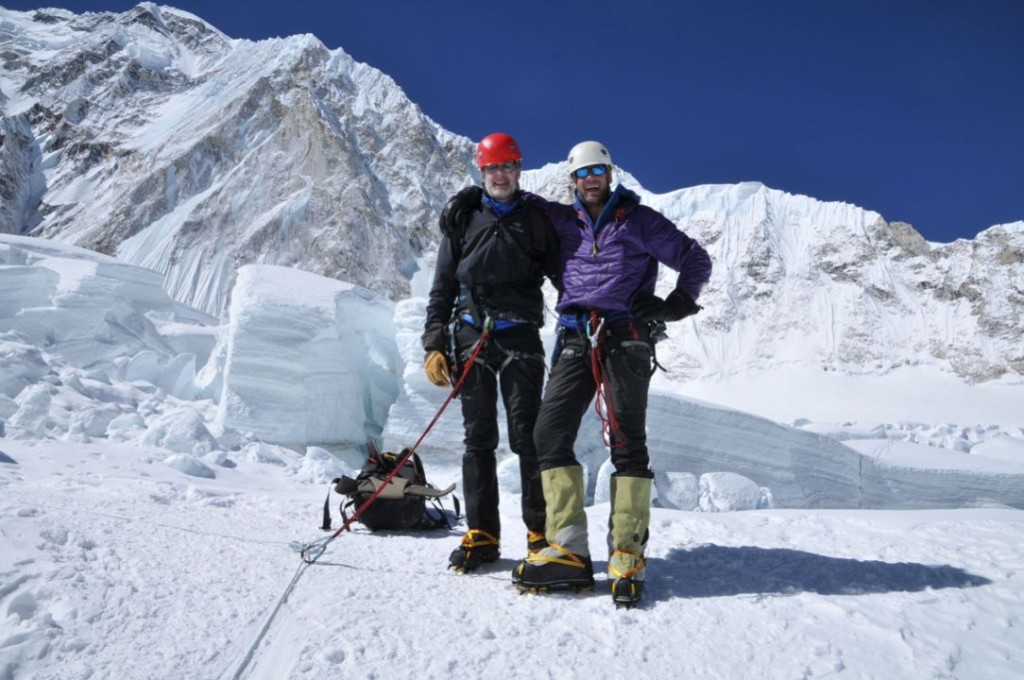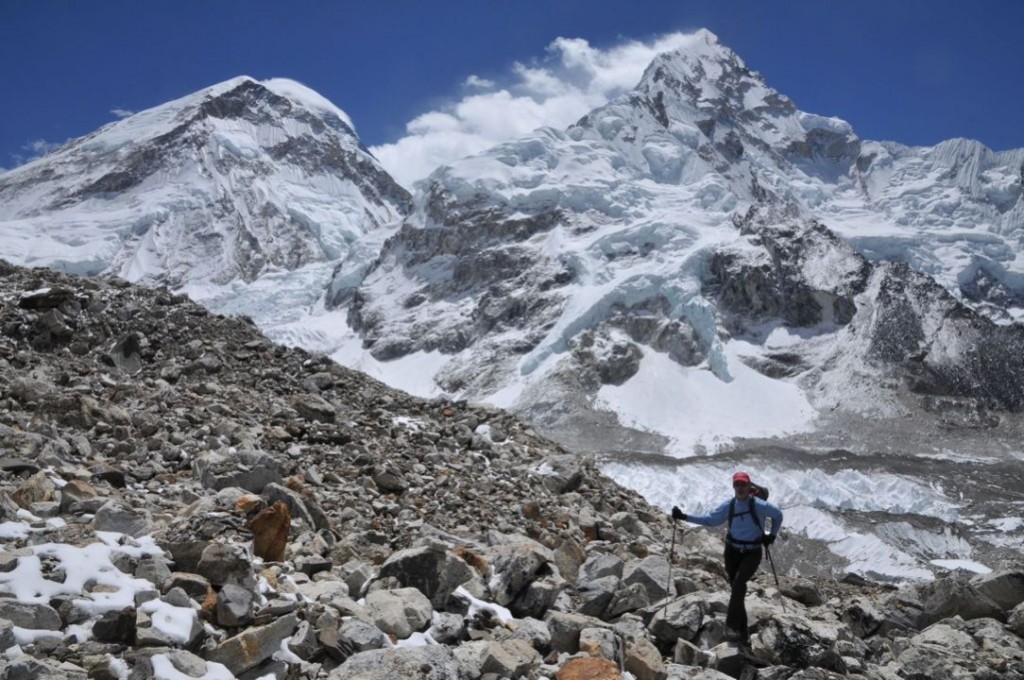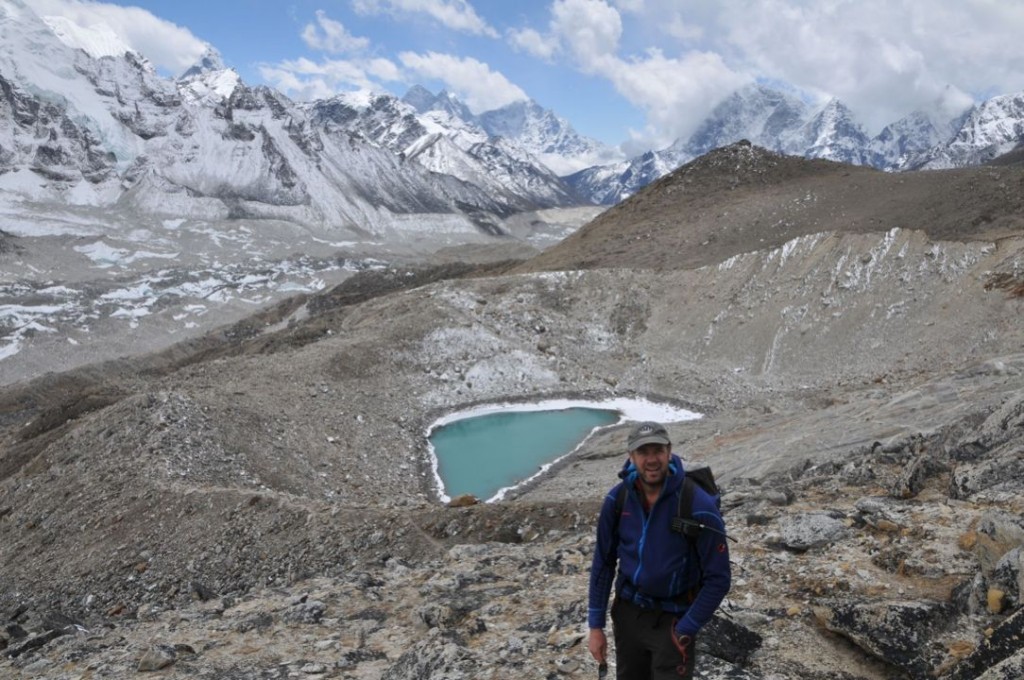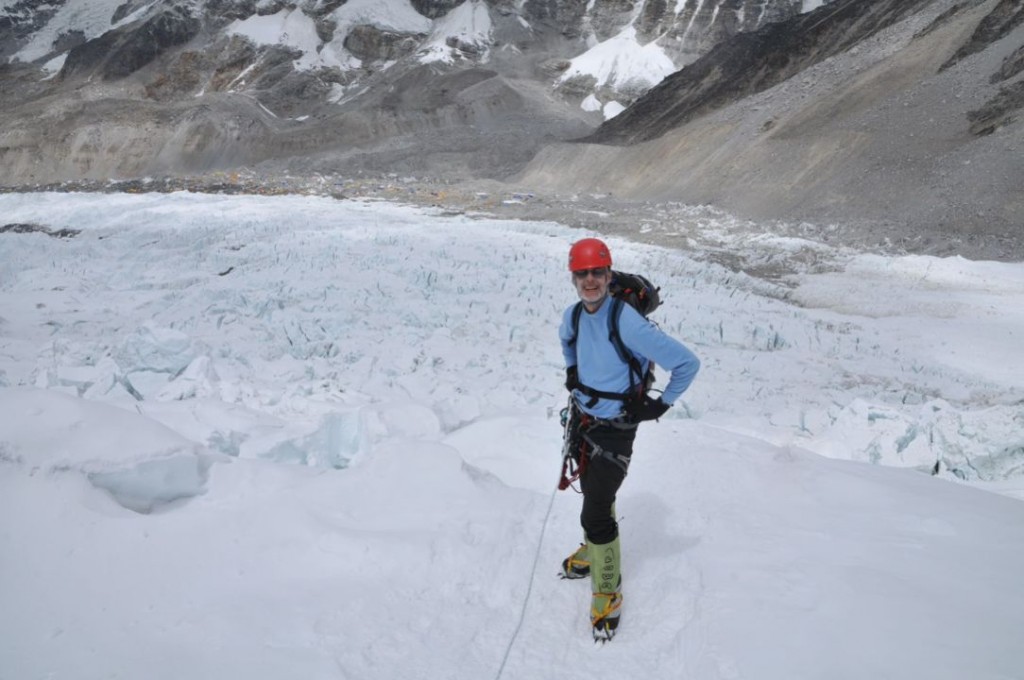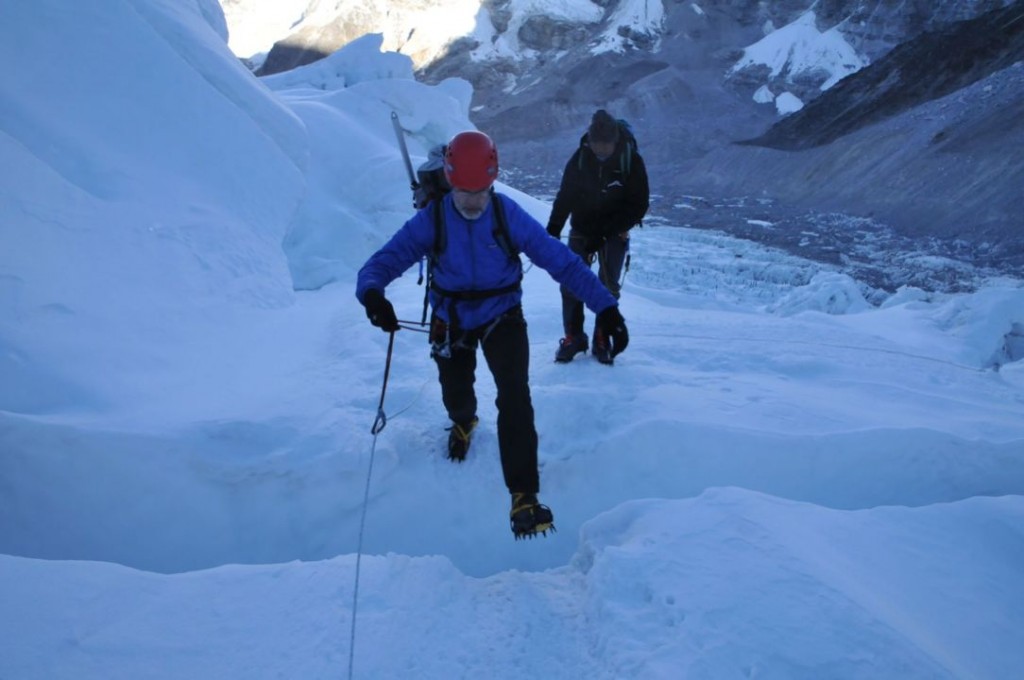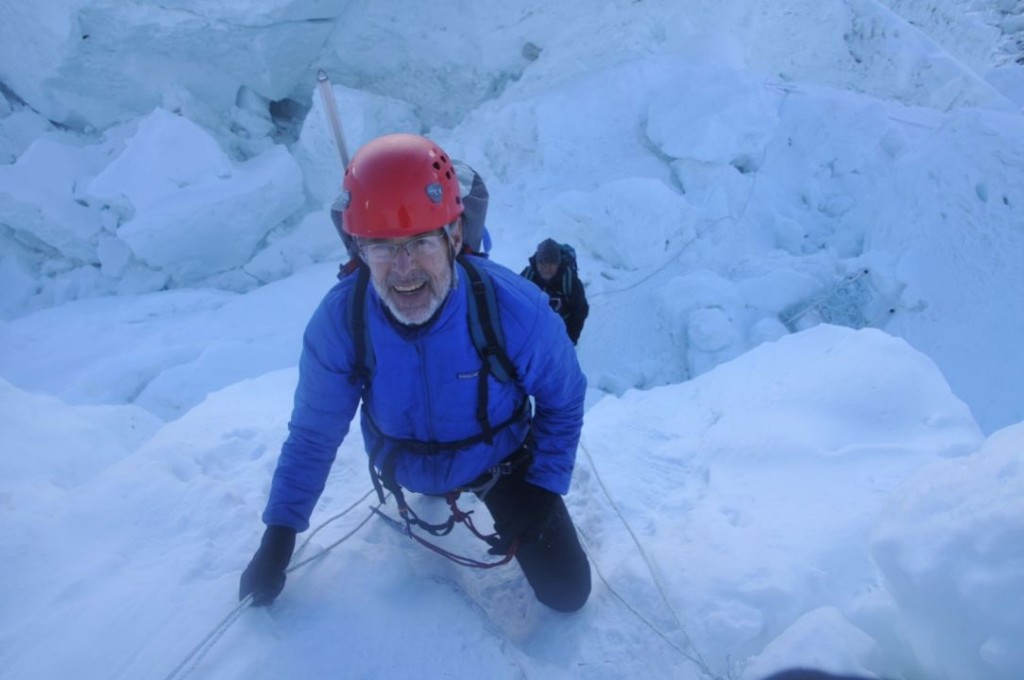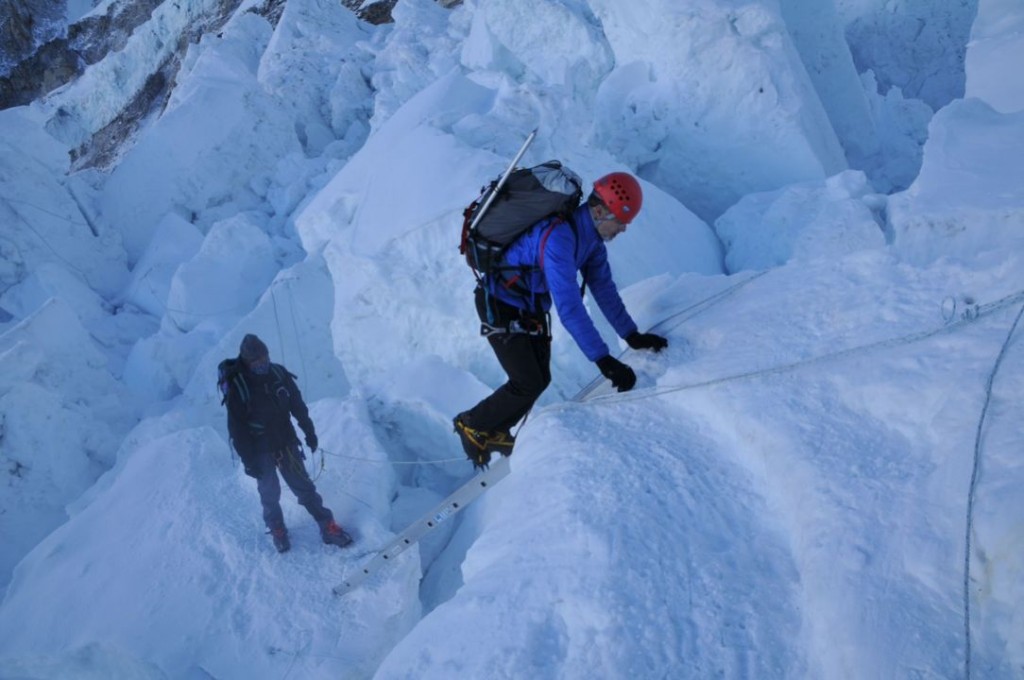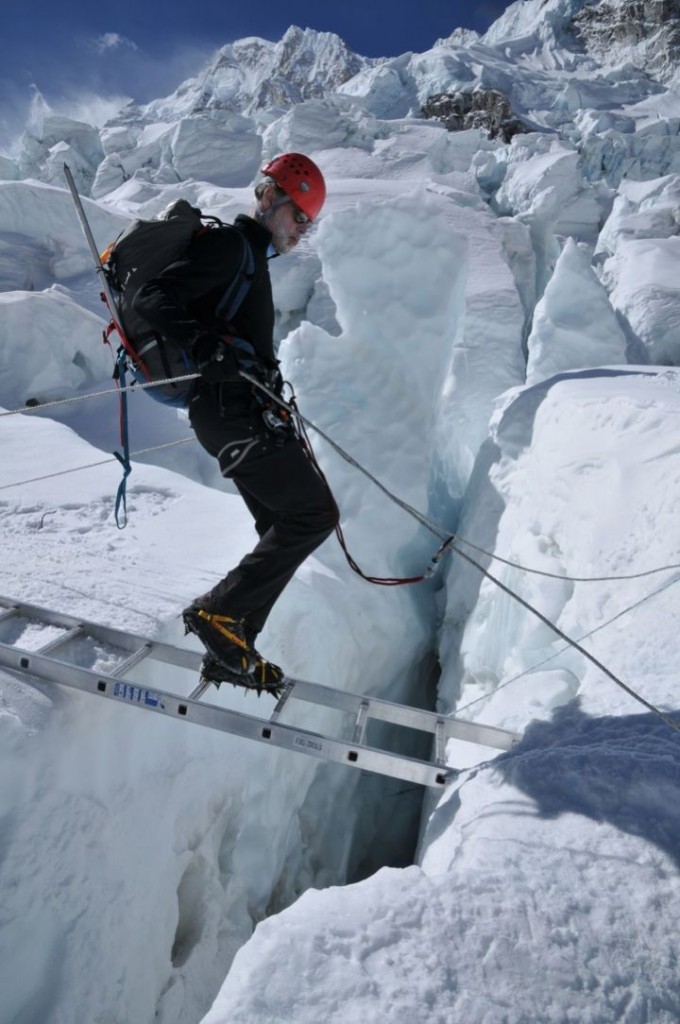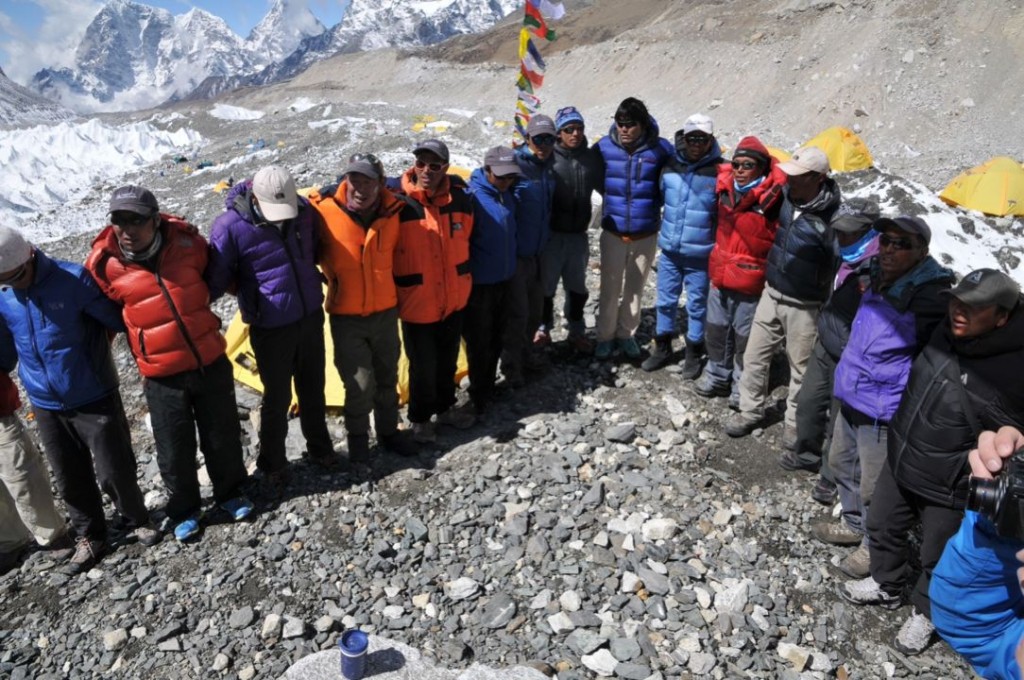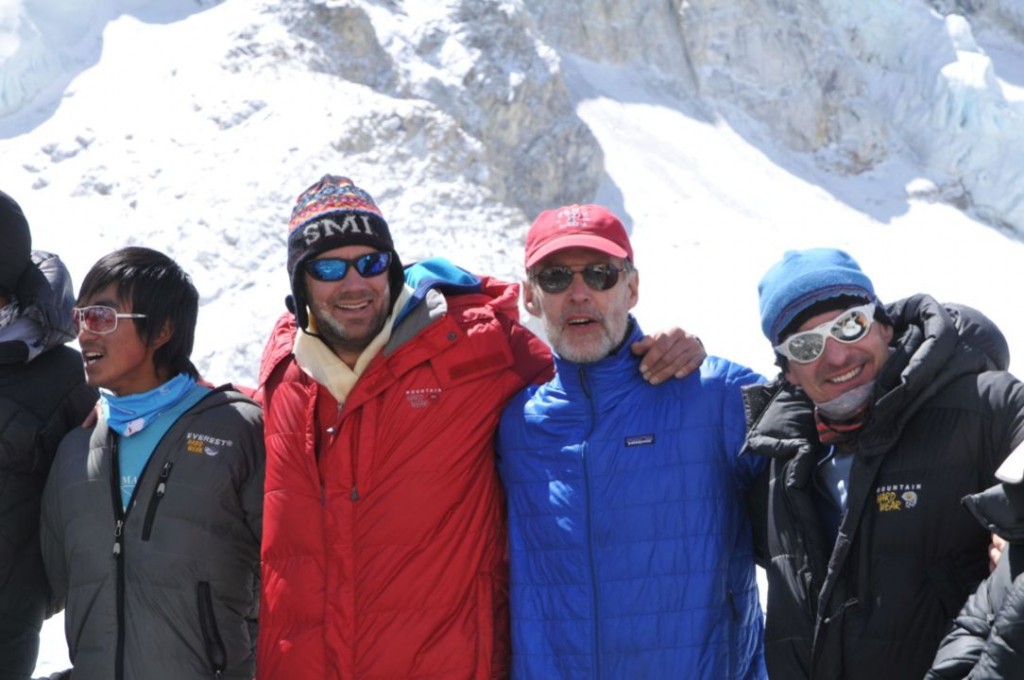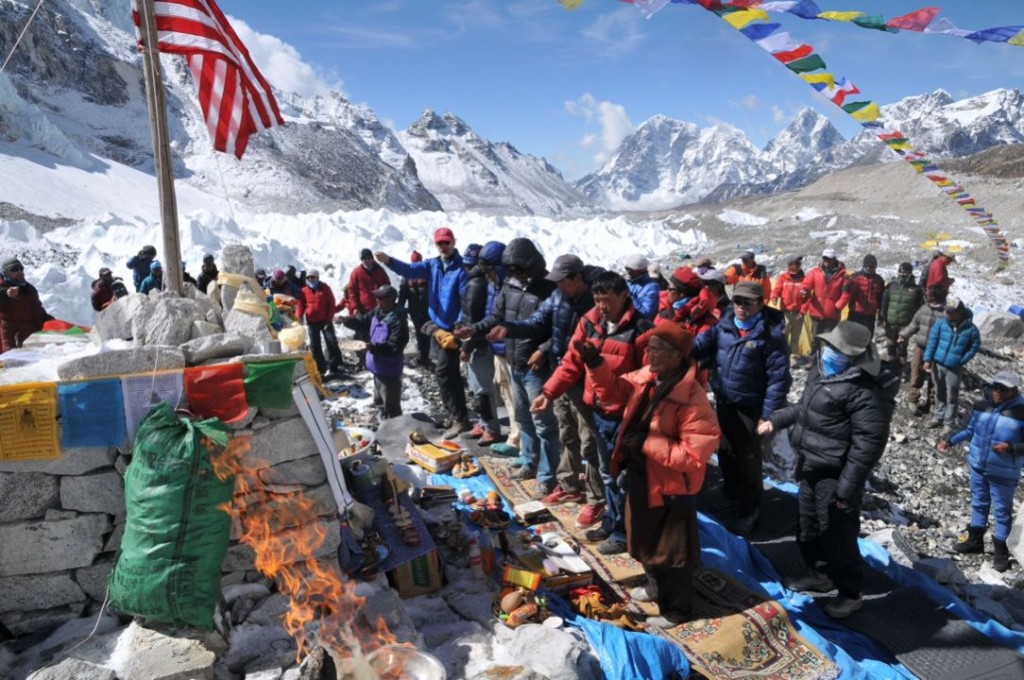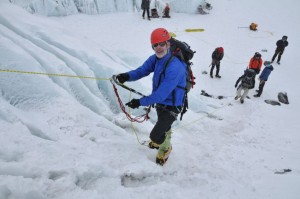Category: Mt. Everest
More from Everest Base Camp!
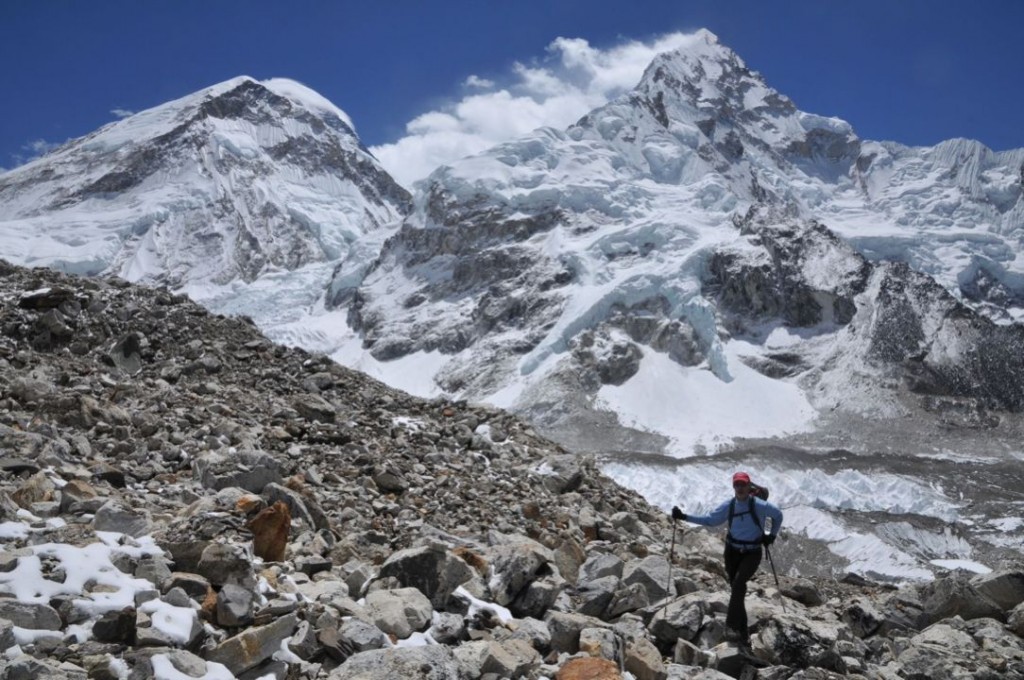
Fred enjoying an acclimatization hike on Pumo Ri above Base Camp with the dramatic backdrop of Nuptse (right) and Everest (left).
Everest Team Reaches Base Camp!
Everest Team Moving Closer to Base Camp!

Mt. Everest (8850m/29,035') and Lhotse (8516m/27,939') the first and fourth highest mountains in the world with the Tenzing Norgay monument in the foreground. The first ascent of Mt. Everest is credited to Sir Edmund Hillary and Tenzing Norgay Sherpa. This monument was built in 2003 in honor of Tenzing Norgay.
After 3 nights in Namche Bazaar we hiked 5 hours to the village of Deboche at 3820m/12,533′ where we spent the nights April 1 and 2 at the Rivendell Lodge.
Deboche is located 40m/131′ below Tengboche, site of the most well known Buddhist monasteries in the Khumbu. The team visited the monastery then went next door to the best bakery in the Khumbu. We sat outside enjoying freshly baked apple pie and chocolate cake under sunny skies with views of Everest (8850m/29,035′), Lhotse (8516m/27,939′), and Ama Dablam (6856m/22,493′).

The entrance to the Tengboche monastery.

Kurt and Fred at the Tengboche monastery.

Inside the Tengboche monastery.
On April 3 the team packed up to move to Pheriche (4240m/13,910′). Along the hike we were treated to a close sighting of a group of Nepalese mountain goats perched on a shelf directly above our trail. Moving higher the team passed through Pangboche where we visited Lama Geshe, a local monk who offered his blessing on our climb. His blessings included chanting, incense burning, and the presentation of a scarf an a choker around each trekker’s neck along with a delicate “head butt”. After our visit the weather turned cloudy and by noon light snow was falling. We stopped at a tea house for lunch then finished our hike to Pheriche with snow creating a thin blanket on our trail.

A Nepalese mountain goat watching us from a perch above our trekking route.

Fred and Kurt on a suspension bridge spanning a river filled gorge far below.

Fred getting a "head butt" blessing from a lama in Pangboche.
The weather cleared on April 4 and the team decided to take an acclimatization day hike above Pheriche where we got nice views of the surrounding peaks. Besides Everest there are many spectacular peaks in this region of the Himalayas. Every new bend in our route reveals more of these beautiful mountains. We feel humbled and truly blessed to be among these great peaks, many of which rise over a mile above us and are relatively unknown among the general mountaineering community. Peaks within our field of view today included Tabuche (6495m/21,308′), Cholatse (6335m/20,784′), and Arakam Tse (6423m/21,072′) as well as the more well known Island Peak (6189m/20,304′), which is one of the most popular trekking peaks in the region.
Located in Pheriche is a high altitude medical clinic that has been in operation since 1973. The Himalayan Rescue Association staffs it with doctors who provide service to trekkers and climbers in need of medical attention. The work done here over the past 39 years has led to a large contribution of what we know about high altitude medicine today. The team visited the clinic in the afternoon after our day hike where one of the doctors shared some insights on high altitude medicine then gave us a tour of the facility.
On April 5 our plan is to move to Lobuche (5290m/17,355′) Base Camp. Lobuche is another trekking peak in the area. It’s Base Camp will be a nice place to continue our acclimatization. We’ll spend three nights here then trek to Everest Base Camp! It looks like we’ll be “out of range” from the outside world during this time. The next time we expect to check in will be after we’re settled at Everest Base Camp.
We want to thank everybody for all your prayers and support during our journey so far. We look forward to being in touch again soon!!

A Sherpani girl in Pangboche.

Sherpa's in Pangboche cultivating their fields preparing for the upcoming growing season when the monsoons come in June.

Yaks being herded past our route as the snow began to fall en route to Pheriche. Yaks are the local beast of burden in Nepal and Tibet. They normally live above 10,000'.

Fred nearing Pheriche Pass (4218m/13,838') en route to the village of Pheriche in a white out while light snow continued to fall.

Fred (right) and fellow team member Bandar (left) crossing a bridge shortly before arriving at Pheriche.

Fred and Kurt arriving at the Himalayan Hotel in Pheriche, the tea house where they slept in for two nights.

Fred, Brad, Lisa, Vanessa, and Karl enjoying the spectacular views on a day hike above Pheriche.

Kurt and Fred pause on a ridgeline where rocks were stacked to hang prayer flags during an acclimatization day hike above Pheriche.

A Himalayan Griffon souring above checking us out during our acclimatization day hike above Pheriche.

SMI founder and guide Kurt Wedberg with Ama Dablam in the background. Kurt climbed this mountain by the Southeast Ridge in October of 1998.

A group picture at approximately 15,000' during an acclimatization day hike above Pheriche. Fred and Kurt are trekking and sharing Base Camp with them during their Everest expedition. Front row: Kurt, Lopsong Sherpa, Bandar, Brad. Back Row: Kevin, Jan, Andy, Karl, Dwayne, Lisa, Catherine, Mark, Ray, John, Jenni, Justin, Vanessa, Fred, Purna, Mingma, Atte, Furi, and Tashi.
Everest Team Healthy And Moving Well

Kurt Wedberg and Fred Simmons on the deck of the Everest View Hotel above Namche Bazaar. The peak to the right is Ama Dablam. Everest is obscured by clouds behind.

Kurt and Fred at the school at Khumjung (3780m/12,401'). After Sir Edmund Hillary became the first person to reach the summit of Mt. Everest he spent much of his life work to helping the Sherpa community. He helped found many schools including this one in 1961. The statue behind is a monument commemorating Hillary.

The village of Namche Bazaar sits in an amphitheater in the mountains of Nepal at 3440m/11,286'.

A Nepali lady at market day in Namche Bazaar.

Yak bells for sale in Namche Bazaar.

Sherpani's conducting business at market day i Namche Bazaar.

Men buying and selling fruit at market day in Namche Bazaar.

A local porter (left) buying fruit at the market in Nmche Bazaar.

The local meat market in Namche Bazaar.

A Nepali man selling hot peppers at the market in Namche Bazaar.

Kids in Khumjung.
Everest Team Is On It’s Way!

Fred and Kurt greeted upon arrival in Kathmandu, Nepal.
Kurt Wedberg and good friend of SMI Fred Simmons have embarked on their much anticipated expedition to Mt. Everest! After all the planning and preparation they had one last meal with Fred’s family in Los Angeles then boarded a Thai Airlines flight bound for Kathmandu, Nepal on March 24. We will attempt to share highlights of the journey through this blog. This is the first entry as written by Kurt Wedberg:

Our last meal with Fred's family before flying to Kathmandu.

Fred boarding our Thai Airlines flight to Kathmandu, Nepal.
Greetings from the town of Phakding at 2620m/8596′ in the Khumbu region of Nepal. All the altitudes are in meters here. To convert we multiply by 3.2808.
After 24+ hours of travel from LA to Kathmandu landing on March 26 we spent two nights and one day in Nepal’s capitol city making final preparations before starting our trek into Everest Base Camp. We organized our equipment into gear that will be shipped by yak directly to Base Camp and other necessities that will be used during our 11-day trek. Fred and I have tacked ourselved onto a large tea run by my good friend Eric who has been organizing Everest expeditions for many years. We will be using all their logistics and support and be able to climb on our own schedule.
On March 28 we left our hotel at 4:45am and soon were at the airport where local flights originate from (versus where the international flights go in and out of). A bit of organized chaos ensued as we got 23 people plus 23 duffle bags through security. Shortly after 6am we were called to our flight and boarded a Twin Otter that holds about 15 people. We divided into two groups on separate planes and took off on the 45 minute flight that ended at the village of Lukla at 2840m/9300′ in the Solu Khumbu region of Nepal. This airport is a trip. The runway is angled at 11 degrees. This helps the airplane stop on this short runway. Upon exiting the plane there are several Nepali police officers who love blowing their whistles incessantly as we walk off the tarmac.
The first order of business was to get 23 porters matched with our 23 duffle bags. While that was going on we took some time to have a little breakfast. There are little bakery’s in Luka that have espresso and cinnamon rolls. This mountaineering business is tough work!! At 7:45am we took off on our trek. Today was a very easy trek. We had very little uphill mixed in with mostly downhill hence how we ended up 220 meters lower than where we started. We took a leisurely pace and got to Phakding 3 hours after leaving Lukla.
We’re staying in tea houses. These are little lodges that exist all up and down the Khumbu region. They have simple bedrooms and a dining room. The menus are pretty similar at all of them. There are American dishes like spaghetti, lasagna, pizza, and chips (french fries to you and me). They also have traditional Nepali food including dahl baht (rice with lentils) and momo’s, which are steamed dumplings with vegetables or meat.
For the next day of our trek we plan to hike approximately 6 hours to Namche Bazar at 3440m/11,286′. We plan to spend 3 nights here acclimatizing before trekking farther up the valley towards Everest Base Camp.
We will try to share a few photos from our journey on this blog. This may not always be possible though so we will also have them posted on the SMI Photo Gallery site here: http://www.kurtwedbergphotography.com/International-Expeditions/Everest-2012/22141785_sRN2QC

Upon arrival in Lukla we had espresso and fresh baked goodies at a local bakery before starting our trek.

Kurt at a Buddhist monument along the trekking route.

A young Sherpa watches from a distance as we trek by his home.

Fred crossing a suspension bridge over the Dudh Koshi River.

